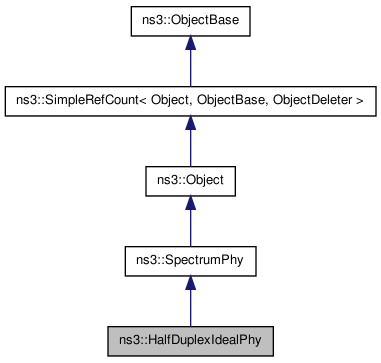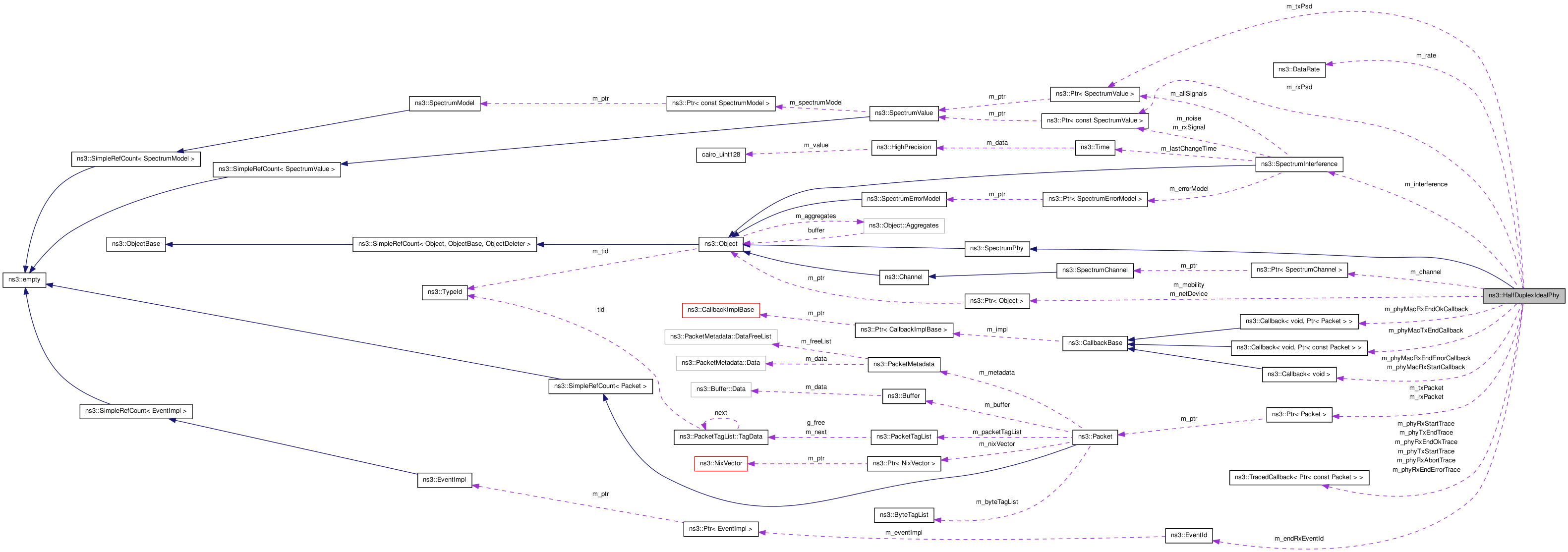#include <half-duplex-ideal-phy.h>


Public Types | |
| enum | State { IDLE, TX, RX } |
Public Member Functions | |
| void | SetChannel (Ptr< SpectrumChannel > c) |
| void | SetMobility (Ptr< Object > m) |
| void | SetDevice (Ptr< Object > d) |
| Ptr< Object > | GetMobility () |
| Ptr< Object > | GetDevice () |
| Ptr< const SpectrumModel > | GetRxSpectrumModel () const |
| void | StartRx (Ptr< PacketBurst > p, Ptr< const SpectrumValue > rxPsd, SpectrumType st, Time duration) |
| SpectrumType | GetSpectrumType () |
| void | SetTxPowerSpectralDensity (Ptr< SpectrumValue > txPsd) |
| void | SetNoisePowerSpectralDensity (Ptr< const SpectrumValue > noisePsd) |
| bool | StartTx (Ptr< Packet > p) |
| void | SetRate (DataRate rate) |
| DataRate | GetRate () const |
| void | SetPhyMacTxEndCallback (PhyMacTxEndCallback c) |
| void | SetPhyMacRxStartCallback (PhyMacRxStartCallback c) |
| void | SetPhyMacRxEndErrorCallback (PhyMacRxEndErrorCallback c) |
| void | SetPhyMacRxEndOkCallback (PhyMacRxEndOkCallback c) |
Static Public Member Functions | |
| static TypeId | GetTypeId (void) |
| This method returns the TypeId associated to ns3::HalfDuplexIdealPhy. | |
Detailed Description
This PHY layer implementation realizes an ideal OFDM PHY which transmits half-duplex (i.e., it can either receive or transmit at a given time). The device is ideal in the sense that: 1) it uses an error model based on the Shannon capacity, which assumes ideal channel coding; 2) it uses ideal signal acquisition, i.e., preamble detection and synchronization are always successful 3) it has no PHY layer overhead
Being half duplex, if a RX is ongoing but a TX is requested, the RX is aborted and the TX is started. Of course, no RX can be performed while there is an ongoing TX.
The use of OFDM is modeled by means of the Spectrum framework. By calling the method SetTxPowerSpectralDensity(), the user can specify how much of the spectrum is used, how many subcarriers are used, and what power is allocated to each subcarrier.
The user can also specify the PHY rate at which communications take place by using SetRate(). This is equivalent to choosing a particular modulation and coding scheme.
The use of the ShannonSpectrumErrorModel allows us to account for the following aspects in determining whether a transmission is successful or not:
- the PHY rate (trades off communication speed with reliability)
- the power spectral density (trade-off among total power consumed, total bandwidth used (i.e., how much of the spectrum is occupied), and communication reliability)
- the signal propagation
Member Enumeration Documentation
PHY states
Member Function Documentation
get the associated NetDevice instance
Implements ns3::SpectrumPhy.
get the associated MobilityModel instance
Implements ns3::SpectrumPhy.
| DataRate ns3::HalfDuplexIdealPhy::GetRate | ( | ) | const |
- Returns:
- the PHY rate used by this PHY.
| Ptr<const SpectrumModel> ns3::HalfDuplexIdealPhy::GetRxSpectrumModel | ( | ) | const [virtual] |
- Returns:
- returns the SpectrumModel that this SpectrumPhy expects to be used for all SpectrumValues that are passed to StartRx. If 0 is returned, it means that any model will be accepted.
Implements ns3::SpectrumPhy.
| SpectrumType ns3::HalfDuplexIdealPhy::GetSpectrumType | ( | ) |
Get the SpectrumType used by this PHY
- Returns:
| static TypeId ns3::HalfDuplexIdealPhy::GetTypeId | ( | void | ) | [static] |
This method returns the TypeId associated to ns3::HalfDuplexIdealPhy.
This object is accessible through the following paths with Config::Set and Config::Connect:
- /NodeList/[i]/DeviceList/[i]/$ns3::AlohaNoackNetDevice/Phy/$ns3::HalfDuplexIdealPhy
- /NodeList/[i]/DeviceList/[i]/$ns3::AlohaNoackNetDevice/Phy/$ns3::SpectrumPhy/$ns3::HalfDuplexIdealPhy
- /NodeList/[i]/DeviceList/[i]/$ns3::BaseStationNetDevice/BsIpcsPacketClassifier/$ns3::HalfDuplexIdealPhy
- /NodeList/[i]/DeviceList/[i]/$ns3::BaseStationNetDevice/BsIpcsPacketClassifier/$ns3::SpectrumPhy/$ns3::HalfDuplexIdealPhy
- /NodeList/[i]/DeviceList/[i]/$ns3::BaseStationNetDevice/LinkManager/$ns3::HalfDuplexIdealPhy
- /NodeList/[i]/DeviceList/[i]/$ns3::BaseStationNetDevice/LinkManager/$ns3::SpectrumPhy/$ns3::HalfDuplexIdealPhy
- /NodeList/[i]/DeviceList/[i]/$ns3::BaseStationNetDevice/SSManager/$ns3::HalfDuplexIdealPhy
- /NodeList/[i]/DeviceList/[i]/$ns3::BaseStationNetDevice/SSManager/$ns3::SpectrumPhy/$ns3::HalfDuplexIdealPhy
- /NodeList/[i]/DeviceList/[i]/$ns3::BaseStationNetDevice/ServiceFlowManager/$ns3::HalfDuplexIdealPhy
- /NodeList/[i]/DeviceList/[i]/$ns3::BaseStationNetDevice/ServiceFlowManager/$ns3::SpectrumPhy/$ns3::HalfDuplexIdealPhy
- /NodeList/[i]/DeviceList/[i]/$ns3::NonCommunicatingNetDevice/Phy/$ns3::HalfDuplexIdealPhy
- /NodeList/[i]/DeviceList/[i]/$ns3::NonCommunicatingNetDevice/Phy/$ns3::SpectrumPhy/$ns3::HalfDuplexIdealPhy
- /NodeList/[i]/DeviceList/[i]/$ns3::SubscriberStationNetDevice/Classifier/$ns3::HalfDuplexIdealPhy
- /NodeList/[i]/DeviceList/[i]/$ns3::SubscriberStationNetDevice/Classifier/$ns3::SpectrumPhy/$ns3::HalfDuplexIdealPhy
- /NodeList/[i]/DeviceList/[i]/$ns3::SubscriberStationNetDevice/LinkManager/$ns3::HalfDuplexIdealPhy
- /NodeList/[i]/DeviceList/[i]/$ns3::SubscriberStationNetDevice/LinkManager/$ns3::SpectrumPhy/$ns3::HalfDuplexIdealPhy
- /NodeList/[i]/DeviceList/[i]/$ns3::SubscriberStationNetDevice/SSScheduler/$ns3::HalfDuplexIdealPhy
- /NodeList/[i]/DeviceList/[i]/$ns3::SubscriberStationNetDevice/SSScheduler/$ns3::SpectrumPhy/$ns3::HalfDuplexIdealPhy
- /NodeList/[i]/DeviceList/[i]/$ns3::UanNetDevice/Channel/NoiseModel/$ns3::HalfDuplexIdealPhy
- /NodeList/[i]/DeviceList/[i]/$ns3::UanNetDevice/Channel/NoiseModel/$ns3::SpectrumPhy/$ns3::HalfDuplexIdealPhy
- /NodeList/[i]/DeviceList/[i]/$ns3::UanNetDevice/Channel/PropagationModel/$ns3::HalfDuplexIdealPhy
- /NodeList/[i]/DeviceList/[i]/$ns3::UanNetDevice/Channel/PropagationModel/$ns3::SpectrumPhy/$ns3::HalfDuplexIdealPhy
- /NodeList/[i]/DeviceList/[i]/$ns3::UanNetDevice/Mac/$ns3::HalfDuplexIdealPhy
- /NodeList/[i]/DeviceList/[i]/$ns3::UanNetDevice/Mac/$ns3::SpectrumPhy/$ns3::HalfDuplexIdealPhy
- /NodeList/[i]/DeviceList/[i]/$ns3::UanNetDevice/Phy/$ns3::HalfDuplexIdealPhy
- /NodeList/[i]/DeviceList/[i]/$ns3::UanNetDevice/Phy/$ns3::SpectrumPhy/$ns3::HalfDuplexIdealPhy
- /NodeList/[i]/DeviceList/[i]/$ns3::UanNetDevice/Transducer/$ns3::HalfDuplexIdealPhy
- /NodeList/[i]/DeviceList/[i]/$ns3::UanNetDevice/Transducer/$ns3::SpectrumPhy/$ns3::HalfDuplexIdealPhy
- /NodeList/[i]/DeviceList/[i]/$ns3::WimaxNetDevice/$ns3::BaseStationNetDevice/BsIpcsPacketClassifier/$ns3::HalfDuplexIdealPhy
- /NodeList/[i]/DeviceList/[i]/$ns3::WimaxNetDevice/$ns3::BaseStationNetDevice/BsIpcsPacketClassifier/$ns3::SpectrumPhy/$ns3::HalfDuplexIdealPhy
- /NodeList/[i]/DeviceList/[i]/$ns3::WimaxNetDevice/$ns3::BaseStationNetDevice/LinkManager/$ns3::HalfDuplexIdealPhy
- /NodeList/[i]/DeviceList/[i]/$ns3::WimaxNetDevice/$ns3::BaseStationNetDevice/LinkManager/$ns3::SpectrumPhy/$ns3::HalfDuplexIdealPhy
- /NodeList/[i]/DeviceList/[i]/$ns3::WimaxNetDevice/$ns3::BaseStationNetDevice/SSManager/$ns3::HalfDuplexIdealPhy
- /NodeList/[i]/DeviceList/[i]/$ns3::WimaxNetDevice/$ns3::BaseStationNetDevice/SSManager/$ns3::SpectrumPhy/$ns3::HalfDuplexIdealPhy
- /NodeList/[i]/DeviceList/[i]/$ns3::WimaxNetDevice/$ns3::BaseStationNetDevice/ServiceFlowManager/$ns3::HalfDuplexIdealPhy
- /NodeList/[i]/DeviceList/[i]/$ns3::WimaxNetDevice/$ns3::BaseStationNetDevice/ServiceFlowManager/$ns3::SpectrumPhy/$ns3::HalfDuplexIdealPhy
- /NodeList/[i]/DeviceList/[i]/$ns3::WimaxNetDevice/$ns3::SubscriberStationNetDevice/Classifier/$ns3::HalfDuplexIdealPhy
- /NodeList/[i]/DeviceList/[i]/$ns3::WimaxNetDevice/$ns3::SubscriberStationNetDevice/Classifier/$ns3::SpectrumPhy/$ns3::HalfDuplexIdealPhy
- /NodeList/[i]/DeviceList/[i]/$ns3::WimaxNetDevice/$ns3::SubscriberStationNetDevice/LinkManager/$ns3::HalfDuplexIdealPhy
- /NodeList/[i]/DeviceList/[i]/$ns3::WimaxNetDevice/$ns3::SubscriberStationNetDevice/LinkManager/$ns3::SpectrumPhy/$ns3::HalfDuplexIdealPhy
- /NodeList/[i]/DeviceList/[i]/$ns3::WimaxNetDevice/$ns3::SubscriberStationNetDevice/SSScheduler/$ns3::HalfDuplexIdealPhy
- /NodeList/[i]/DeviceList/[i]/$ns3::WimaxNetDevice/$ns3::SubscriberStationNetDevice/SSScheduler/$ns3::SpectrumPhy/$ns3::HalfDuplexIdealPhy
- /NodeList/[i]/DeviceList/[i]/$ns3::WimaxNetDevice/BandwidthManager/$ns3::HalfDuplexIdealPhy
- /NodeList/[i]/DeviceList/[i]/$ns3::WimaxNetDevice/BandwidthManager/$ns3::SpectrumPhy/$ns3::HalfDuplexIdealPhy
- /NodeList/[i]/DeviceList/[i]/$ns3::WimaxNetDevice/BurstProfileManager/$ns3::HalfDuplexIdealPhy
- /NodeList/[i]/DeviceList/[i]/$ns3::WimaxNetDevice/BurstProfileManager/$ns3::SpectrumPhy/$ns3::HalfDuplexIdealPhy
- /NodeList/[i]/DeviceList/[i]/$ns3::WimaxNetDevice/Channel/$ns3::UanChannel/NoiseModel/$ns3::HalfDuplexIdealPhy
- /NodeList/[i]/DeviceList/[i]/$ns3::WimaxNetDevice/Channel/$ns3::UanChannel/NoiseModel/$ns3::SpectrumPhy/$ns3::HalfDuplexIdealPhy
- /NodeList/[i]/DeviceList/[i]/$ns3::WimaxNetDevice/Channel/$ns3::UanChannel/PropagationModel/$ns3::HalfDuplexIdealPhy
- /NodeList/[i]/DeviceList/[i]/$ns3::WimaxNetDevice/Channel/$ns3::UanChannel/PropagationModel/$ns3::SpectrumPhy/$ns3::HalfDuplexIdealPhy
- /NodeList/[i]/DeviceList/[i]/$ns3::WimaxNetDevice/ConnectionManager/$ns3::HalfDuplexIdealPhy
- /NodeList/[i]/DeviceList/[i]/$ns3::WimaxNetDevice/ConnectionManager/$ns3::SpectrumPhy/$ns3::HalfDuplexIdealPhy
- /NodeList/[i]/DeviceList/[i]/$ns3::WimaxNetDevice/Phy/Channel/$ns3::UanChannel/NoiseModel/$ns3::HalfDuplexIdealPhy
- /NodeList/[i]/DeviceList/[i]/$ns3::WimaxNetDevice/Phy/Channel/$ns3::UanChannel/NoiseModel/$ns3::SpectrumPhy/$ns3::HalfDuplexIdealPhy
- /NodeList/[i]/DeviceList/[i]/$ns3::WimaxNetDevice/Phy/Channel/$ns3::UanChannel/PropagationModel/$ns3::HalfDuplexIdealPhy
- /NodeList/[i]/DeviceList/[i]/$ns3::WimaxNetDevice/Phy/Channel/$ns3::UanChannel/PropagationModel/$ns3::SpectrumPhy/$ns3::HalfDuplexIdealPhy
Attributes defined for this type:
-
Rate: The PHY rate used by this device
- Set with class: DataRateValue
- Underlying type: DataRate
- Initial value: 1000000bps
- Flags: construct write read
TraceSources defined for this type:
- TxStart: Trace fired when a new transmission is started
- TxEnd: Trace fired when a previosuly started transmission is finished
- RxStart: Trace fired when the start of a signal is detected
- RxAbort: Trace fired when a previously started RX is aborted before time
- RxEndOk: Trace fired when a previosuly started RX terminates successfully
- RxEndError: Trace fired when a previosuly started RX terminates with an error (packet is corrupted)
Reimplemented from ns3::SpectrumPhy.
| void ns3::HalfDuplexIdealPhy::SetChannel | ( | Ptr< SpectrumChannel > | c | ) | [virtual] |
set the associated NetDevice instance
- Parameters:
-
d the NetDevice instance
Implements ns3::SpectrumPhy.
Set the mobility model associated with this device.
- Parameters:
-
m the mobility model
Implements ns3::SpectrumPhy.
| void ns3::HalfDuplexIdealPhy::SetNoisePowerSpectralDensity | ( | Ptr< const SpectrumValue > | noisePsd | ) |
- Parameters:
-
noisePsd the Noise Power Spectral Density in power units (Watt, Pascal...) per Hz.
| void ns3::HalfDuplexIdealPhy::SetPhyMacRxEndErrorCallback | ( | PhyMacRxEndErrorCallback | c | ) |
set the callback for the end of a RX in error, as part of the interconnections betweenthe PHY and the MAC
- Parameters:
-
c the callback
| void ns3::HalfDuplexIdealPhy::SetPhyMacRxEndOkCallback | ( | PhyMacRxEndOkCallback | c | ) |
set the callback for the successful end of a RX, as part of the interconnections betweenthe PHY and the MAC
- Parameters:
-
c the callback
| void ns3::HalfDuplexIdealPhy::SetPhyMacRxStartCallback | ( | PhyMacRxStartCallback | c | ) |
set the callback for the start of RX, as part of the interconnections betweenthe PHY and the MAC
- Parameters:
-
c the callback
| void ns3::HalfDuplexIdealPhy::SetPhyMacTxEndCallback | ( | PhyMacTxEndCallback | c | ) |
set the callback for the end of a TX, as part of the interconnections betweenthe PHY and the MAC
- Parameters:
-
c the callback
| void ns3::HalfDuplexIdealPhy::SetRate | ( | DataRate | rate | ) |
set the PHY rate to be used by this PHY.
- Parameters:
-
rate
| void ns3::HalfDuplexIdealPhy::SetTxPowerSpectralDensity | ( | Ptr< SpectrumValue > | txPsd | ) |
set the Power Spectral Density of outgoing signals in power units (Watt, Pascal...) per Hz.
- Parameters:
-
txPsd
| void ns3::HalfDuplexIdealPhy::StartRx | ( | Ptr< PacketBurst > | p, | |
| Ptr< const SpectrumValue > | rxPsd, | |||
| SpectrumType | st, | |||
| Time | duration | |||
| ) | [virtual] |
Notify the SpectrumPhy instance of an incoming waveform
- Parameters:
-
p the PacketBurst associated with the incoming waveform rxPsd the Power Spectral Density of the incoming waveform. The units of the PSD are the same specified for SpectrumChannel::StartTx(). st spectrum type duration the duration of the incoming waveform
Implements ns3::SpectrumPhy.
Start a transmission
- Parameters:
-
p the packet to be transmitted
- Returns:
- true if an error occurred and the transmission was not started, false otherwise.
The documentation for this class was generated from the following files:
- src/devices/spectrum/half-duplex-ideal-phy.h
- doc/introspected-doxygen.h
 1.7.1
1.7.1